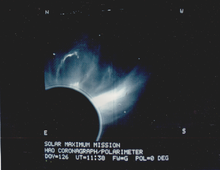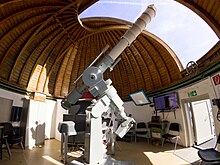Coronagraph

A coronagraph is a
Invention
The coronagraph was introduced in 1931 by the French astronomer
Design

Coronagraph instruments are extreme examples of stray light rejection and precise photometry because the total brightness from the solar corona is less than one-millionth the brightness of the Sun. The apparent surface brightness is even fainter because, in addition to delivering less total light, the corona has a much greater apparent size than the Sun itself.
During a
As examples, imaging instruments on the Hubble Space Telescope and James Webb Space Telescope offer coronagraphic capability.
Band-limited coronagraph
A band-limited coronagraph uses a special kind of mask called a band-limited mask.[2] This mask is designed to block light and also manage diffraction effects caused by removal of the light. The band-limited coronagraph has served as the baseline design for the canceled Terrestrial Planet Finder coronagraph. Band-limited masks will also be available on the James Webb Space Telescope.
Phase-mask coronagraph
A phase-mask coronagraph (such as the so-called four-quadrant phase-mask coronagraph) uses a transparent mask to shift the phase of the stellar light in order to create a self-destructive interference, rather than a simple opaque disc to block it.
Optical vortex coronagraph
An optical vortex coronagraph uses a phase-mask in which the phase shift varies azimuthally around the center. Several varieties of optical vortex coronagraphs exist:
- the scalar optical vortex coronagraph based on a phase ramp directly etched in a dielectric material, like fused silica.[3][4]
- the vector(ial) vortex coronagraph employs a mask that rotates the angle of polarization of photons, and ramping this angle of rotation has the same effect as ramping a phase-shift. A mask of this kind can be synthesized by various technologies, ranging from extrasolar planets.
This works with stars other than the sun because they are so far away their light is, for this purpose, a spatially coherent plane wave. The coronagraph using interference masks out the light along the center axis of the telescope, but allows the light from off axis objects through.
Satellite-based coronagraphs
Coronagraphs in
While space-based coronagraphs such as LASCO avoid the sky brightness problem, they face design challenges in stray light management under the stringent size and weight requirements of space flight. Any sharp edge (such as the edge of an occulting disk or optical aperture) causes Fresnel diffraction of incoming light around the edge, which means that the smaller instruments that one would want on a satellite unavoidably leak more light than larger ones would. The LASCO C-3 coronagraph uses both an external occulter (which casts shadow on the instrument) and an internal occulter (which blocks stray light that is Fresnel-diffracted around the external occulter) to reduce this leakage, and a complicated system of baffles to eliminate stray light scattering off the internal surfaces of the instrument itself.
Aditya-L1

Aditya-L1 is a coronagraphy spacecraft developed by the
The primary payload, Visible Emission Line Coronagraph (VELC), will send 1,440 images of the sun daily to ground stations. The VELC payload has been developed by the Indian Institute of Astrophysics (IIA) and will continuously observe the Sun's corona from the L1 point.[7][8]
The mission has stringent cleanliness protocols, including a ban on the use of perfumes and sprays by scientists and engineers working on the payload, to prevent contamination that could affect the sensitive instruments.[8]
Extrasolar planets
The coronagraph has recently been adapted to the challenging task of finding planets around nearby stars. While stellar and solar coronagraphs are similar in concept, they are quite different in practice because the object to be occulted differs by a factor of a million in linear apparent size. (The Sun has an apparent size of about 1900
A stellar coronagraph concept was studied for flight on the canceled Terrestrial Planet Finder mission. On ground-based telescopes, a stellar coronagraph can be combined with adaptive optics to search for planets around nearby stars.[10]
In November 2008, NASA announced that a planet was directly observed orbiting the nearby star Fomalhaut. The planet could be seen clearly on images taken by Hubble's Advanced Camera for Surveys' coronagraph in 2004 and 2006.[11] The dark area hidden by the coronagraph mask can be seen on the images, though a bright dot has been added to show where the star would have been.
Up until the year 2010,
See also
- List of solar telescopes
- New Worlds Mission – A proposed external coronagraph
References
- ^ "SPARTAN 201-3: Coronagraphs". umbra.nascom.nasa.gov. Retrieved 2020-03-30.
- S2CID 18095697.
- PMID 16389814.
- ^ Optical vortex coronagraph Archived 2006-09-03 at the Wayback Machine
- ^ "NICMOS". STScI.edu. Retrieved 2020-03-30.
- ^ Explained: Aditya-L1, India's First Solar Mission
- ^ a b VELC payload aboard Aditya-L1 will send 1,440 images of sun a day
- ^ a b Strict Measures: Scientists, engineers working on Aditya-L1 weren’t allowed to wear perfumes for THIS reason
- S2CID 119544105.
- ^ "Gemini Observatory Board Goes Forward with Extreme Adaptive Optics Coronagraph". www.adaptiveoptics.org. Retrieved 2020-03-30.
- ^ "NASA - Hubble Directly Observes a Planet Orbiting Another Star". www.nasa.gov. Retrieved 2020-03-30.
- ^ Andrea Thompson (2010-04-14). "New method could image Earth-like planets". msnbc.com. Retrieved 2020-03-30.
External links
- Overview of Technologies for Direct Optical Imaging of Exoplanets, Marie Levine, Rémi Soummer, 2009
- "Sun Gazer's Telescope." Popular Mechanics, February 1952, pp. 140–141. Cut-away drawing of first Coronagraph type used in 1952.
- Optical Vectorial Vortex Coronagraphs using Liquid Crystal Polymers: theory, manufacturing and laboratory demonstration Optics Infobase
- The Vector Vortex Coronagraph: Laboratory Results and First Light at Palomar Observatory IopScience
- Annular Groove Phase Mask Coronagraph IopScience
- This link shows an HST image of a dust disk surrounding a bright star with the star hidden by the coronagraph.[1]
